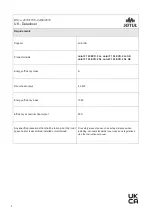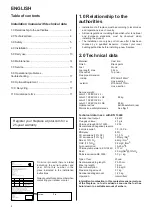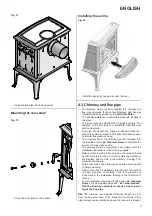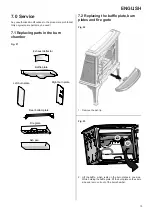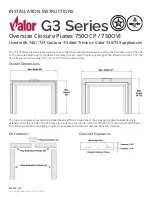
13
Condensed water coming from the
fi
replace appears as a
black, tar-like liquid. This should be wiped o
ff
immediately
to avoid discoloration of the
fi
replace,
fl
oor or surrounding
building components.
It is important to get the wood burning quickly to avoid
condensation.
If the condensation continues, mineral sand can be placed on
the bottom plate.
5.0 Daily use
Odours when using the
fi
replace for the
fi
rst time
• When
the
fi
replace is used for the
fi
rst time, it may emit
an irritating gas which may smell slightly. This happens
because the paint dries.The gas is not toxic but the room
should be thoroughly ventilated. Let the
fi
re burn with a
high draught until all traces of the gas have disappeared
and no smoke or odours can be detected.
Heating advice
NB:
Logs that have been stored outdoors or in a cold room
should be brought indoors 24 hours before use to bring them
up to room temperature.
There are various ways of heating the stove but it is always
important to be careful about what you put in the stove. See
the section on
“Wood quality”
.
Wood quality
By quality wood we mean most well-known types of wood
such as birch, spruce and pine.
The logs should be dried so that the moisture content is no
more than 20%.
To achieve this, the logs should be cut during the late winter.
They should be split and stacked in a way that ensures good
ventilation. The wood stacks should be covered to protect the
logs from rain. The logs should be brought indoors during early
autumn and stacked/stored for use in the coming winter.
Refuelling on to a low
fi
re bed
If there is insu
ffi
cient burning material in the
fi
rebed to light
a new fuel charge, excessive smoke emission can occur.
Refuelling must be carried out onto a su
ffi
cient quantity of
glowing embers and ash that the new fuel charge will ignite in
a reasonable period.If there are too few embers in the
fi
re bed
add suitable kindling to prevent excess smoke.
Be especially careful never to use the following
materials as fuel in your
fi
replace:
• Household rubbish, plastic bags, etc.
• Painted or impregnated timber (which is extremely toxic).
• Laminated wooden planks.
• Driftwood
These may harm the product and are also pollutants.
NB: Never use petrol, para
ffi
n, methylated spirit or similar
liquids to light the
fi
re. You may cause serious injury to
yourself and damage to the product.
Wood consumption
Jøtul F 100 ECO.2 has a nominal heat output of
ca. 4,9 kW
.
Use of wood, with nominal heat emission: Approx.
1,6 kg/h.
Another important factor for proper fuel consumption is that
the logs are the correct size. The size of the logs should be:
Kindling:
Length:
approx. 25-33 cm
Diameter:
2 - 5 cm
Amount per fi re:
6 - 8 pieces.
Firewood (split logs):
Recommend length:
25 - 33 cm
Diameter:
approx. 8 cm
Intervals for adding wood: Approximately every 45 minutes
Size of the fi re:
1,23 kg (nominal heat output)
Amount per load:
2
pieces
Nominal heat output is achieved when the air vent is open
approximately 50 %
(
fi
g. 17
) The ignition vent is closed.
The maximum amount of fuel speci
fi
ed in this manual
should not be exceeded, overloading can cause excess
smoke.
Ash removal
Jøtul F 100 ECO.2 has an ash pan which makes it easy to
remove the ashes.
• Only remove ashes when the
fi
replace is cold.
Fig. 19
1. Scrape the ashes through the grate into the ash pan.
2. Make sure that the ash pan doesn’t
fi
ll up so high that it
keeps ash from coming through the grate into the pan.
3. Open the
fi
re grate.
ENGLISH


